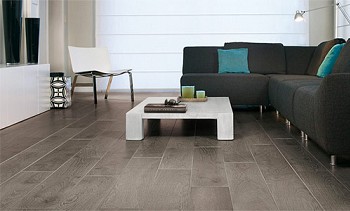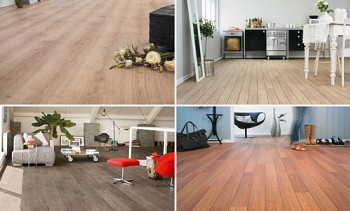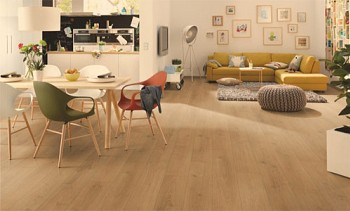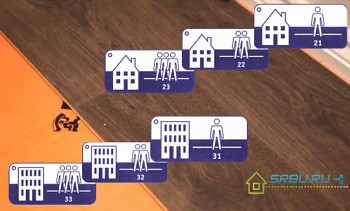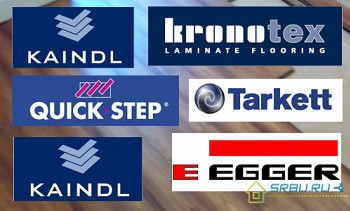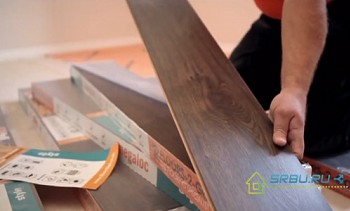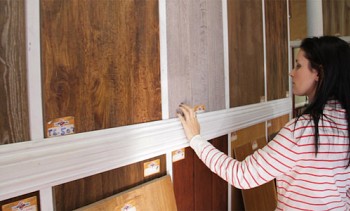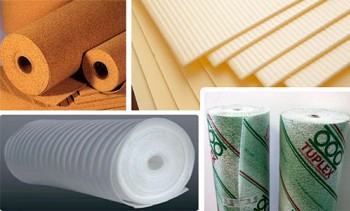Today, the laminate on the wall in the interior is increasingly common. Designers appreciated this practical material, which allows you to quickly decorate floors, ceilings and even walls. It compares favorably with a variety of drawings and textures that imitate wood, parquet, stone or other materials. It is quite simple to look after him, he retains his original appearance for a long time.
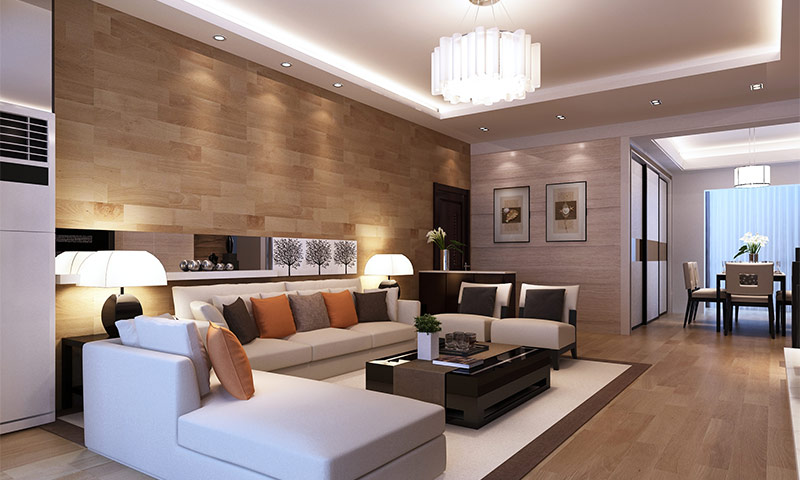
Content:
What laminate can be used for wall decoration
You can use the same laminate for wall decoration as for the floor. But since the load on the material placed on the wall will not be high, it is possible to use a laminate of small thickness and a lower wear resistance class.
Currently, the most common are the following locks used to connect the laminate boards:

The most common type is click-type. Finishing the walls with a laminate of this kind is possible on a finished wooden frame or on a flat surface with glue. Between themselves, the panels snap into place.

A laminate with a Lock type lock, or as it is also called grooved, provides an equally strong fastening. It is also mounted on a wooden grate using brackets or studs.
Tip: do not fix the laminate on the wooden grid with glue, since the adhesion area to the surface in this case decreases, and the panel can peel off at any time. To fix the laminate to the crate, special clips are used or screwed with small screws.

Tip: if it is important for the floor to buy a durable wear-resistant laminate of 31 silt and 32 class, then thin material of class 21 is suitable for the wall. At a cost it will come out much cheaper.
Methods of fixing and positioning the laminate on the wall
Before buying a laminate, experts advise to determine the method of laying it. If you need to sheathe a small room, then the glue method is more suitable. It allows you to save the area of the room. If a wooden frame can be mounted in a spacious room, then it is better to choose this method of fastening. It is easier to assemble and holds more securely on the wall.
How to glue laminate on the wall
To save space in a small room, it is better to use a thin laminate, which can be simply glued to the wall with silicone or liquid nails. But there is one main condition - the wall must be absolutely smooth, otherwise the contact area of the board with the wall will be insufficient and the laminate will not adhere properly. Most often, the walls in panel houses are leveled with drywall. It is an ideal base for gluing flat laminated boards.
The installation process includes several stages:
- the prepared surface is measured and the place of attachment of the first board is determined;
- glue is applied to the back of the board and to the wall (in a wave or around the perimeter);
- the board is pressed tightly to the surface, using the building level so that the boards are laid evenly;
- while gluing the rest of the boards, wipe the glue protruding between the seams.
Video. Fixing the laminate on the wall with glue
Installation of click boards
The ends of the click laminate are equipped with a lock that clicks into place. From here and the name of this species. Click connection is quite strong, it combines boards well into a single canvas. To lay the laminate on the wall quickly and last longer, use the following sequence:
- Measure the wall and prepare the necessary tools and materials (jigsaw, screwdriver, drill, dowels, screws, stapler, wooden slats and laminate);
- From wooden slats, a grid is made on the wall, on which laminated boards will be attached;
- To fix the slats with a drill, holes are drilled in the wall into which the dowels are inserted, and then the rail is screwed into them with screws;
- Reiki is screwed over the entire area of the wall, actively using the construction level so that they are fixed evenly;
- Laminate is assembled from the bottom up, fastening the boards together with a lock and nailing with a stapler or screwing to wooden slats.
Video. Laying a laminate with Click on the wall
Installation of sheet pile
The tongue board is mounted only on a wooden frame. For fastening it is not necessary to use glue, enough staples or small nails. Reliable locks hold the boards together well. The scheme and sequence of fastening of the tongue-and-groove laminate is the same as that of the clutch.
Some useful styling tips:
- Before mounting the laminate on the wall, carefully consider the pattern on all boards. So you can select boards with a defect or inexpressive pattern, and boards that fit well in color and pattern together;
- When the wooden crate of the slats is ready, measure it again. It may not be possible to sheathe it with whole laminated panels only; some of them will have to be sawn. Measurements will help arrange entire panels symmetrically to the center;
- During the assembly process, the brackets and nails must be driven in tightly so that the caps do not interfere with fixing the panel locks to each other.
How to better place laminate boards on the wall
Laminate wall decoration is possible in several ways: horizontal, vertical and diagonal.
Horizontal way. Suitable for decorating small rooms. Horizontal stripes allow you to visually expand the room. But if the room has low ceilings, then you should not sew up the entire wall to the ceiling with a laminate. Such styling will visually reduce the height of the room. During installation, each row of boards is better to cascade or staggered so that the joints are not located one above the other.
Vertical way. Laying the laminate on the wall in a vertical way visually increases the height of the room. It is well suited for rooms with low ceilings. But if the room is narrow, it is better not to use this method, since it will stretch it even more.
Diagonal way. The diagonal way of laying the laminate on the wall looks very original. It makes the interior design stylish and original. But this method is the most difficult, since the boards need to be cut at an angle and adjusted to each other. Material consumption is also greater than with vertical or horizontal laying.
How to decorate the walls of various rooms with a laminate
Varieties of the finish coating of the laminate, its thickness and wear resistance allow you to choose the option for almost any room.
For the bathroom
The bathroom is a room with extreme conditions for any finishing material. In this room, the air temperature and its humidity are constantly changing, water can get on any surface. But for such conditions, you can choose a laminate. It is better to give preference to a water resistant rather than a moisture resistant product. The waterproof laminate on the wall in the bathroom interior will last a long time and create a unique design of the room.
For kitchen
Laminate in the kitchen can completely finish all the walls, if the design of the room is made in eco-style or country. Most often, a laminate is used to finish one wall, in which the working area is located. Or decorate an apron over the work area. You can use ordinary laminated panels, or you can pick up products with a special protective coating. It is good if the laminate will be combined with furniture and flooring.
For the living room
Using a laminate on a wall in the interior of a living room is a successful interior solution that allows you to solve several problems at once:
- Firstly, decorative. The laminate is selected for a warm shade for dark rooms, whose windows face the north side. Thus, the room becomes cozier and warmer.For rooms with southern windows, light, cold tones are selected. They balance the color palette, making the space lighter and cooler;
- Secondly, practical. If you sheathe a wall with a laminate on which a TV or home theater is located, then you can hide the wires between the sheathing and the wall;
- Third, ease of care. It is easy to remove fingerprints, stains, splashes and other spots from the laminate. Therefore, it can be placed on a wall with living plants, the leaves of which are often sprayed.
For bedroom
In the bedroom, laminate wall decoration is also relevant. Usually in this way they decorate the wall behind the head of the bed. Wall lights or paintings are placed on this wall. If the bedroom is large and it has an artificial fireplace, then the fireplace area can also be decorated with a laminate.
Tip: it is better to choose a laminate to match the tone of furniture. It is laid in any convenient way - horizontal, vertical or diagonal.
For the corridor
Laminate wall decoration in the hallway is practical and beautiful. In the corridor there are many people every day - residents of the house or guests. The walls in this room are often dirty or overwritten. If in the corridor one wall is sewn up with laminate, or laminated panels are made around the perimeter of the room, the problem of pollution will be solved.












































